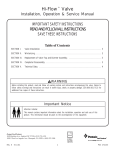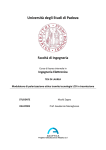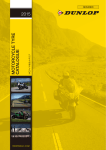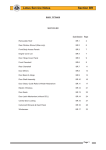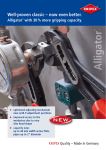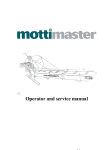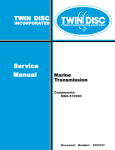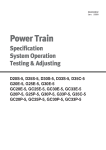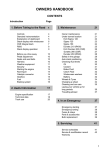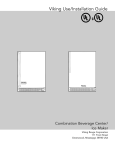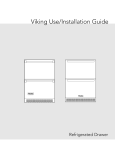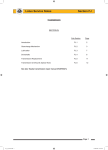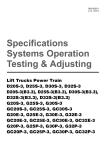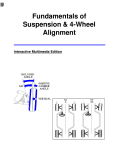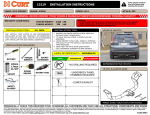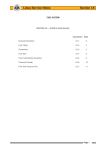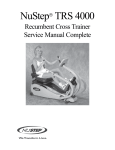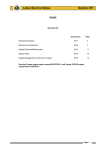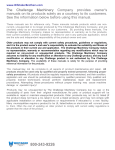Download Lotus Service Notes Section CI
Transcript
Lotus Service Notes Section CI FRONT SUSPENSION SECTION CI Sub-Section Page General Description CI.1 3 Geometry & Adjustments CI.2 3 Anti-Roll Bar CI.3 7 Suspension Disassembly/Assembly CI.4 8 Front Wheel Bearings CI.5 10 Page 1 Lotus Service Notes Section CI GENERAL LAYOUT Spring/damper unit Top wishbone Steering tie rod Upper swivel joint Track rod end Steering arm Anti-roll bar mounting Anti-roll bar Bottom wishbone Hub carrier Wheel hub Lower steering swivel joint c34b Page 2 Lotus Service Notes Section CI CI.1 - GENERAL DESCRIPTION The fully independent front suspension comprises, on each side of the car, upper and lower wishbones, a concentric coil spring/telescopic damper unit, and a tubular anti-roll bar. A forged steel hub carrier, provides a mounting for a the hub bearing unit to which the road wheel is attached via four spline socket bolts. The upper and lower 'A' frame wishbones are fabricated from steel tube, the upper wishone braced by sheet steel gussets at its apex, and the lower wishbone braced by a tubular strut at its base. The inboard ends of both wishbones use replaceable bonded rubber pivot bushes to provide maintenance free articulation, with a specification providing accurate and responsive dynamic characteristics. The outer ends of both wishbones incorporate housings into which the upper and lower steering swivel ball joints are pressed. The upper ball pin is secured to the forged steel, rearward facing steering arm, itself fixed to the hub carrier by two M10 bolts. The ball pin of the lower swivel joint is secured directly into a tapered hole in the bottom of the forged steel hub carrier. The Bilstein spring/damper unit acts between the outer end of the lower wishbone and the chassis, and is fitted with the damper rod lowermost in order to minimise unsprung weight. A forward mounted tubular steel anti-roll bar, is supported in chassis mounted rubber pivot bushes and is operated via short ball jointed drop links from the lower wishbones. CI.2 - GEOMETRY & ADJUSTMENTS Provision is made for the adjustment of wheel alignment, camber and castor. Under normal service conditions, no periodic scheduled check of the geometry is necessary, although a front wheel alignment check is recommended when the front tyres are replaced. A full geometry check is required only after front suspension repair, or if excessive tyre wear is evident, or if steering difficulties are encountered. Before any measurements or adjustments are made it is essential first to set the vehicle to its ‘mid-laden’ ride height, approximating to driver and passenger and a half tank of fuel. This will require the vehicle to be ballasted, or tied down: Standard Elise Mid-laden ride height (reference height for geometry check); - front 130 mm below front end of chassis siderail - rear 130 mm below rear end of chassis siderail Camber - optimum - 0.1° - tolerance + 0.1° to - 0.3°; Max side/side 0.2° Castor - optimum + 3.8° - tolerance + 3.5° to + 4.1°; max. side/side: 0.35° Alignment - optimum Zero - tolerance 0.5 mm toe-out to 0.7 mm toe-in overall (0.07° toe-out to 0.10° toe-in overall) Steering axis inclination 12° nominal Roadsport Elise, Exige Mid-laden ride height (reference height for geometry check); - front 130mm below front end of chassis siderail - rear 130mm below rear end of chassis siderail Camber - optimum - 0.3° - tolerance - 0.1° to - 0.5°; max. side/side: 0.2° Castor - optimum + 3.8° - tolerance + 3.5° to + 4.1°; max. side/side: 0.35° Alignment - optimum Zero - tolerance 0.5 mm toe-out to 0.5 mm toe-in overall (0.07° toe-out to 0.07° toe-in overall) Steering axis inclination 12° nominal Page 3 Lotus Service Notes Section CI Alignment Wheel alignment refers to the parallelism of the wheels when viewed from above and is crucial to vehicle stability, handling and tyre wear. Difference between rim measurements = overall toe out FRONT Individual toe out angle c26 Alignment is measured either by the angle a wheel makes with the vehicle centre line, or the difference in dimension between the wheel rim to wheel rim measurement at the front and rear of the wheel at hub centre height. The wheels are said to 'toe-in' when the wheel paths converge ahead of the vehicle, and 'toe-out' when they diverge. Wheel alignment is designed to vary with both steering angle (Ackerman) and suspension travel (bump steer) and should be measured only 'straight ahead' at the specified ride height. Front wheel alignment is adjusted be screwing the track rods into or out of the track rod outer end ball joints. In order to preserve the required bump steer characteristic and steering symmetry, the effective length of each track rod must remain equal - adjust each track rod by a similar amount. Track rod end flats Steering rack gaiter Track rod end Steering arm Steering track rod flats Track rod end locknut c28a - Hold the track rod end using the flats provided, and slacken the locknut. Repeat for the opposite side. Turn each track rod a similar amount. As a guide, turning both track rods by one quarter of a turn will alter overall toe-out by approx. 2.0 mm. When adjustment is correct, hold each track rod end and tighten the locknuts to 80 - 82 Nm (58 - 60 lbf. ft). When slackening or tightening the track rod end locknuts, it is important that the torque reaction is resisted using the track rod end flats, and that the ball joint itself is not allowed to be stressed. Page 4 Lotus Service Notes Section CI Camber Adjustment Camber is the angle from vertical of the wheel when viewed from the front, and is said to be negative when the wheel leans inwards at the top (positive when leaning outwards). The primary purpose of camber is to achieve the maximum efficiency of the tyre under cornering loads and body roll, with the specification closely allied to a particular wheel/tyre combination. The camber angle changes with suspension travel, becoming more negative on bump, and should be measured only at the specified ride height. Incorrect camber can result in handling deficiencies and excessive tyre wear. Camber angle Vertical c29 Wheel centreline Camber adjustment is effected by adding or deleting shim plates between the steering arm (to which the upper steering swivel joint is fixed) and the hub carrier. Camber adjustment shimplate Steering arm Hub carrier - c30a Shimplates are available in 1mm and 3mm thicknesses. Reducing the shim pack thickness will increase negative camber. Adding shims will reduce negative camber. A 1mm shim plate will alter camber by approximately 0.25°. Apply Permabond A130 (A912E7033) to the two steering arm fixing bolts, and tighten to 45 Nm Page 5 Lotus Service Notes Section CI Castor Adjustment Castor is the angle from vertical of the steering axis of the wheel when viewed from the side. Its primary purpose is to provide a natural straight running tendency of the steered wheels with forward vehicle motion. Castor angles have a complex interaction with other steering geometries and if unbalanced or outside of specification, can result in various stability and handling deficiencies. FRONT Top & bottom steering swivels Castor angle c27 The wishbone pivot bushes are bonded rubber type with a plastic flanged outer sleeve, a plain steel inner sleeve, and a plastic interleaf sleeve within the rubber bush to control the flexing characteristic. The top wishbone rear bush, identified by a blue paint mark, has no interleaf sleeve. The top wishbone pivots are sandwiched between the walls of transverse chassis box sections, the pick up points in which are reinforced either with machined inserts, or in the case of the foremost position, a thick alloy plate, each being bonded to the chassis with epoxy adhesive. Spacer washers are fitted ahead of and behind each of the top wishbone pivot bushes to allow the wishbone to be displaced forwards or backwards, with an associated change of castor angle. A rubber faced snubber washer fitted against the rear face of the top wishbone front bush prevents metal to metal contact under extreme braking forces. The spacer washers may be re-distributed between the front and rear of each pivot bush but the snubber washer position, and the total shim pack thickness of 4 x 1.5mm at each pivot (inc. the 1.5mm snubber washer) must remain unchanged. Top Wishbone Inboard Fixing FRONT Front leg Rear leg 1.5mm shim washers Bonded plate Page 6 Rubber faced snubber washer 1.5mm shim washers Bonded inserts Plastic interleaf Flanged plastic outer sleeve Inner steel sleeve c32 Lotus Service Notes - Section CI Notes Shim distribution at the front bush of either wishbone must be copied at the rear bush of that wishbone. Transferring a 1.5mm shim washer from ahead of, to behind the pivot bushes, will reduce castor by approximately 0.4°. Transferring a 1.5mm shim washer from behind, to ahead of the pivot bushes, will increase castor by approximately 0.4°. Ensure that the load spreading washers are correctly located beneath the bolt heads and nuts as shown in the drawings. Ensure that the pivot bolts are tightened only with the vehicle at ride height. Torque to 45 Nm. CI.3 - ANTI-ROLL BAR A tubular steel anti-roll bar is mounted in pivot bushes onto the front face of the chassis, and is linked to the outboard ends of each lower front wishbone via short ball jointed links. The chassis mounted pivots use rubber bushes for noise isolation, and are retained by alloy clamp brackets. Washers welded to the bar bear against the inner sides of the bushes to provide lateral location of the bar. Castrol LMX rubber grease, or equivalent, should be used when fitting the rubber bushes onto the anti-roll bar. To remove the bar, the alloy bracket at each side, connecting the bottom of the crash structure to the chassis, must be first be removed by drilling out the rivets. Anti-Roll Bar Mounting - Rubber Spacer plate Rubber mounting Clamp bracket Fixing bolts c40 Page 7 Lotus Service Notes Section CI Anti-Roll Bar Drop Link Lower wishbone Anti-roll bar drop link Anti-roll bar c31 CI.4 - SUSPENSION DISASSEMBLY/ASSEMBLY The suspension may be disassembled without the use of any special tools other than a 'Torx' socket for the hub bearing carrier bolts, and a spring compressor, required only if the spring is to be removed from the damper unit. With the car on a wheel free lift and with the front wheels removed: 1. Remove the wheelarch liner(s) as appropriate. 2. Remove the two bolts securing the brake caliper to the hub carrier, release the flexible hose from the top wishbone, and support the caliper aside without straining the brake hose. Release the single countersunk screw, and remove the brake disc. 3. Remove the nut securing the track rod end into the steering arm, and use a ball joint splitter to separate the rod end from the arm. 4. Remove the nut securing the top swivel joint to the steering arm, and use a ball joint splitter to separate the joint from the arm. Remove the two M10 fixing bolts and remove the steering arm from the hub carrier, taking care not to misplace the camber adjustment shim plates. 5. Remove the nut securing the lower swivel joint to the hub carrier, and use a ball joint splitter to separate the ball pin from the carrier. 6. Remove the bolts securing the spring/damper unit to the lower wishbone and chassis anchor bracket, and withdraw the unit, noting the spacer washers fitted at the top end. 7. Disconnect the anti-roll bar drop link from the lower wishbone, and remove the lower wishbone front pivot bolt. 8. Remove the lower wishbone rear pivot bolt from within the cabin footwell, and withdraw the wishbone. 9. Before removing the two pivot bolts for the top wishbone, take careful note of the distribution of castor adjustment washers. Move the steering rack to full lock to provide clearance for the withdrawal of the wishbone rear pivot bolt. Withdraw the wishbone. 10. The wishbone pivot bushes comprise a rubber bush bonded to a steel inner sleeve and a flanged plastic outer sleeve. The bushes may be pressed out of the wishbone eyes, and new bushes fitted using suitable press tool dollies. Smear the outer surface of the new bush with IPC 'P-80' rubber lubricant emulsion Page 8 Lotus Service Notes Section CI (A082C6042V) to ease fitment, and assemble as follows: Top wishbone - insert from the outside of both pivot eyes (from front of front eye, and rear of rear eye). Lower wishbone - insert from the inside of both pivot eyes (from rear of front eye, and front of rear eye). Note that all top wishbone pivot bushes are common with the exception of the top wishbone rear pivot, which contains no interleaf sleeve and is identified by a blue paint mark. 11. Top and bottom swivel joints are identical, and may be replaced if necessary using a suitable press. 12. If the anti-roll bar is to be removed; remove the front alloy undertray, and, by drilling out the rivets, the small alloy closing panel at each side of the crash structure below the anti-roll bar. Release the a.r. bar clamps and drop links, and withdraw the bar. 13. The road spring may be removed from the damper using a suitable spring compressor to allow the spring lower slotted seat to be withdrawn. Note that spring upper seat is located by a square section circlip on the damper body: - Standard Elise: Use centre of 3 grooves for mid-laden ride height of 130mm. - USA Elise: Use lower of 3 grooves for mid-laden ride height of 135mm. - Elise with Roadsports suspension package and non-USA Exige: Use the upper of 2 grooves for midladen ride height of 130mm. 14. To remove the hub bearing unit from the hub carrier, release the three Torx head bolts and withdraw the complete unit. The hub unit is not serviceable, and is replaced complete if faulty. Reassembly Re-assemble the suspension in reverse order to disassembly with the following notes: Take care to assemble each pivot bolt with the correct washers/snubbers/spacers as shown in the diagrams. Smear the shank of each pivot bolt with PBC grease, but do not allow contamination of the threads. Take care to refit the original camber adjustment shimpack, and distribute the castor shims as noted on removal. Top ball joint plinth fixing bolts: The bolts securing the steering arm/top ball joint plinth to the hub carrier were upgraded in March '04 at VIN serial number 1537 (approx.) in order to commonise with motorsport applications. Earlier type 8.8 grade bolts should be tightened to 45 Nm; Later 10.9 grade bolts to 68 Nm. The bolt grade is stamped around the head of the bolt. The thread of both bolt types should first be treated with Permabond A130 (A912E7033V). After re-fitting a standard anti-roll bar, ensure that the crash structure closing panels are re-rivetted. Lubricate the rubber type anti-roll bar mountings with rubber grease and the Nylon type with MoS2 grease. Apply Permabond A130 (A912E7033V) to the threads of the steering arm bolts. Lubricate the ends of the damper top eye bush with rubber grease. Press the brake pedal to reposition the pads before driving the car. If the car suffers a suspension impact sufficient to damage a wheel rim, careful attention should be paid to all related suspension components. Such forces can cause stretching of the lower ball pin and consequent fixing nut torque loss. As a safety precaution, it is recommended that in all such cases, the lower ball joint and the two bolts securing the upper ball joint plinth to the hub carrier are renewed. The Service Schedule specifies that the security of the front and rear suspension is checked at each service. For cars used on race tracks, or in similar conditions, suspension components and torque checks should be carried out between sessions. This operation requires that all the principal suspension pivot bolts are torque checked, noting the following points: Where a bolt is tapped into a housing or weldnut, and relies on a thread locking compound for security, it is important to appreciate that if the bolt is disturbed, the locking compound must be re-applied. The following procedure should be adopted for all such fixings: Check the torque of the fixing. If the specified torque is attained without the fixing being disturbed (moving), take no further action. If the bolt moves, the locking action of the thread adhesive will have been compromised. Remove the Page 9 Lotus Service Notes - Section CI bolt completely, clean off all old adhesive using a wire brush and acetone, and apply new adhesive as specified. Refit the bolt and tighten to the specified torque. If for any reason a bolt is found to have become loose, and the car has been operated for any period in this condition, the bolt should be renewed as a standard precaution and related components carefully inspected for hole ovality or wear. Torque Settings: Upper and lower wishbone pivot bolts Upper swivel joint to steering arm Lower swivel joint to plinth Steering arm to hub carrier - 8.8 grade - 10.9 grade Track rod end to steering arm Damper to lower wishbone Damper to top anchor bracket Damper anchor bracket to chassis Hub bearing unit to hub carrier Brake caliper to hub carrier Anti-roll bar rubber bush mounting clamps Anti-roll bar drop links Nm 45 55 55 45 68 30 45 45 25 90 45 25 45 CI.5 - FRONT WHEEL BEARINGS The sealed front wheel bearings are contained in a steel housing secured to the hub carrier with three 'Torx' bolts. The double row, angular contact, ball bearing is retained in the outer housing and also onto the hub spigot by a shoulder and a peening operation, and is inseparable for service. Note that all four hub assemblies are common, and incorporate a wheel speed sensor in the bearing unit, with a flying lead terminating in an electrical connector plug secured by a camber shim plate bracket. If there is found to be any discernible free play in the hub bearing, or any roughness or tight spots can be felt, or any signs of lubricant expulsion are evident, the hub assembly should be replaced - there is no provision for adjustment. To Replace Hub Bearing Assembly 1. With the wheel removed, release the two fixing bolts, and remove the brake caliper from the hub carrier. Support clear of the brake disc without straining the flexible hose. Release the single countersunk screw and withdraw the brake disc from the hub. 2. Using a Torx socket, release the three bolts securing the hub bearing unit to the hub carrier. 3. Fit the new hub bearing unit to the hub carrier and retain with the three Torx bolts. Torque tighten to 90 Nm. 4. Refit the brake disc and caliper, using Permabond A130 (A912E7033) to the threads of the caliper fixing bolts and torque tightening to 45 Nm. Pump the brake pedal to reposition the pads before driving the car. Page 10 Lotus Service Notes Section CI Steering arm Hub carrier Hub Hub to carrier fixing bolt Swaged bearing retention c41a Double row ball bearing Page 11 Lotus Service Notes Section CI CI.3 - ANTI-ROLL BAR Reserved A tubular steel anti-roll bar is mounted in pivot bushes onto the front face of the chassis, and is linked to the outboard ends of each lower front wishbone via short ball jointed links. On cars fitted with the motorsport anti-roll bar, the ends of the uprated bar are equipped with 5 holes to allow some adjustment of roll stiffness to be made. Standard setting is centre hole. Using a more forward hole increases stiffness. Two types of mounting are used to secure the anti-roll bar to the front face of the chassis. Standard Elise models use rubber pivot bushes for noise isolation, retained by alloy clamp brackets. Washers welded to the bar bear against the inner sides of the bushes to provide lateral location of the bar. Castrol LMX rubber grease, or equivalent, should be used when fitting the rubber bushes onto the anti-roll bar. For the anti-roll bars used with roadsport suspension and on Exige, the bar is secured by two Nylon clamps, fixed to the chassis via the front lower wishone inboard front pivot bolt, with a 'top hat' section steel spacer preventing the clamp from being crushed. These hard type mountings provide optimum steering response but will transmit more noise and require periodic lubrication with MoS2 grease at 3,000 mile (5,000 km) intervals. Note that the two types of mounting require differently shaped bars, with that for the rubber mounts being positioned higher on the chassis than the hard mount version. Anti-Roll Bar Mounting - Rubber Spacer plate Rubber mounting Clamp bracket c40 bolt tube Reserved Anti-Roll Bar Mounting - Nylon Page 12 Wishbone pivot Spacer












